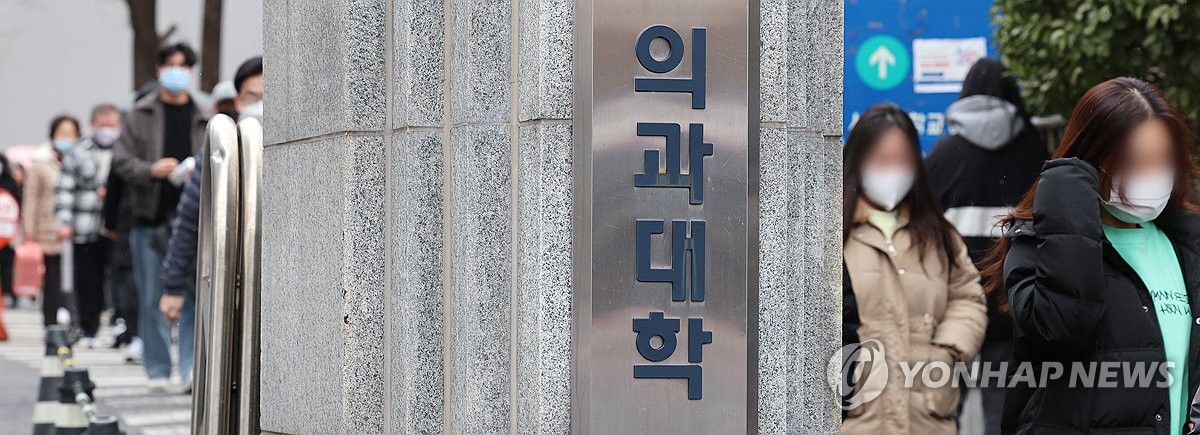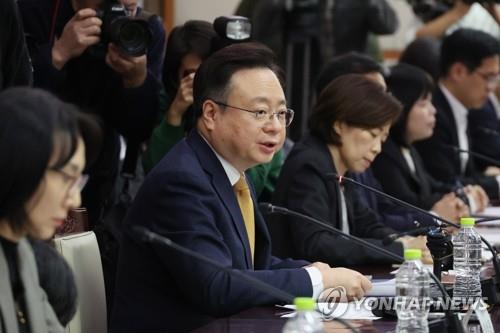- California Assembly OKs highest minimum wage in nation
- S. Korea unveils first graphic cigarette warnings
- US joins with South Korea, Japan in bid to deter North Korea
- LPGA golfer Chun In-gee finally back in action
- S. Korea won’t be top seed in final World Cup qualification round
- US men’s soccer misses 2nd straight Olympics
- US back on track in qualifying with 4-0 win over Guatemala
- High-intensity workout injuries spawn cottage industry
- CDC expands range of Zika mosquitoes into parts of Northeast
- Who knew? ‘The Walking Dead’ is helping families connect
Number of medical students to be boosted by 2,000 next year, while doctors warn of strike
Health Minister Cho Kyoo-hong said Tuesday the government plans to boost the number of medical students by 2,000 next year to help ease public health concerns in rural areas, while a major business lobby of doctors warned of a strike over the plan.
The decision will raise the number of freshmen for medical schools to 5,058 starting next year, marking the first increase since 1998. Since 2006, the medical school enrollment quota has been capped at 3,058.
“The government has been undertaking bold reformative programs in the wake of the dire situation in which the essential medical sectors stand at the edge of the cliff,” Cho told reporters.

Cho said the planned increase was necessary considering that the country is set to experience a shortage of 15,000 doctors in 2035.
Based on the calculation, Cho said the newly admitted medical students are expected to commence graduating in 2031, partially alleviating the anticipated supply shortage.
“The government will regularly control the supply of doctors by considering factors, such as the aging population, disease outbreaks and advancements in medical technology,” Cho said.
The minister noted that it plans to focus on allocating the additional quota to medical schools based outside the greater Seoul area.

The plan, however, is expected to draw fierce protests from doctors, who claim that establishing public hospitals and offering better salaries would be more effective in encouraging doctors to work in rural areas and the essential health care field.
Earlier in the day, the Korean Medical Association, a lobby group of doctors, warned that it would launch a nationwide strike if the government “unilaterally” pushes for raising the medical school enrollment quota.
“Despite repeated suggestions from the medical circle, the government has been pushing for its own policy measures without ample discussions and consultations,” Lee Pil-soo, the association’s head, told reporters hours before the decision was announced.
Lee offered to resign from his position later in the day, saying he is “deeply concerned” with the situation and that the association plans to begin its protest after the upcoming Lunar New Year holiday ends early next week.
In response to the possible strike by doctors across the country, the government issued a prohibition order on collective action against the medical association’s executive branch and raised the national health crisis level to “alert.”
“The government and the medical sector are collaborators and companions, joining forces under the common goal of ensuring the life and health of the people,” the health minister said, urging doctors to cooperate with the new policy.
“If doctors engage in illegal activities, we will take actions under the principle and the law, in accordance with our legal duty,” Cho said.
The minister also pointed out that the decision was not made unilaterally, with approximately 80 percent of the population expressing support for the government’s initiative to raise the quota.
“The matter cannot rely solely on negotiations between the government and the medical association. As far as I know, no countries determine medical school enrollments through such negotiations,” he added.

The country has been grappling with a shortage of doctors in crucial areas, as medical professionals tend to prefer practicing in nonessential areas with lower risks. In contrast, the demand for emergency care has surged in the wake of the aging population.
Enrollment in medical schools, initially at 3,507 in the early 2000s, had experienced a gradual decline through 2006. This reduction was attributed to government efforts to address the concerns of doctors protesting the policy of separating the prescribing and dispensing of drugs.
On the previous day, the Korean Intern Resident Association said that its poll of around 10,000 doctors showed that 88.2 percent of the respondents will carry out collective actions, including strikes, should the government proceed with raising the medical school quota.
Amid the strong protest from the medical circle, South Korea vowed to provide a set of incentives for the medical community last week, including allocating 10 trillion won (US$7.5 billion) by 2028 to enhance compensation for medical services in crucial areas.
The government said it will also institute a “safety net” to limit doctors’ criminal liability in cases of malpractice, aiming to allow health care professionals to prioritize emergency treatments while ensuring swift compensation for patients.
“Even if the new policy is implemented in 2025, it will take up to 10 years (to address the supply shortage),” Cho said. “Thus, the government is planning to enact a comprehensive policy package tailored to essential fields, providing incentives for doctors to choose to practice in these areas.”
According to the data compiled by the Organization for Economic Cooperation and Development (OECD), the number of doctors for every 1,000 people came to 2.6 in South Korea, far below the member countries’ average of 3.7.
Separate research conducted by the Korea Institute for Health and Social Affairs showed that on average, South Koreans spent 4.3 minutes during their primary meeting with doctors, compared with the OECD members’ average of 16.4 minutes.












